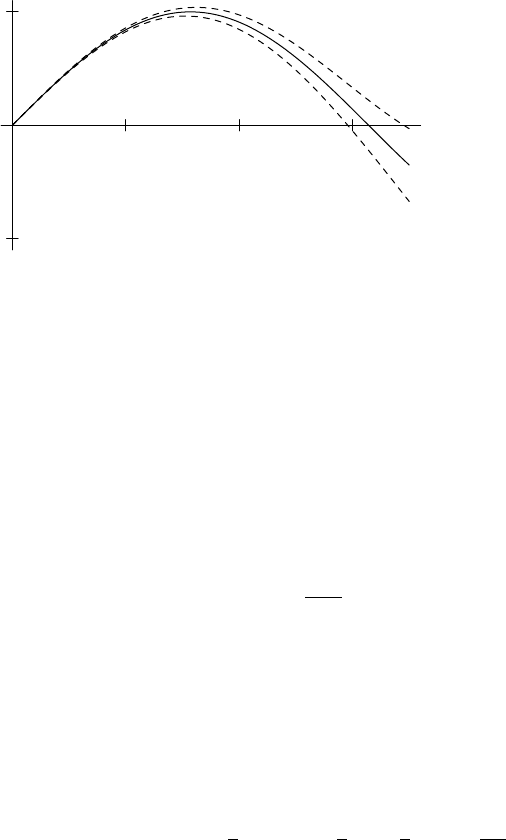Davidson K.R., Donsig A.P. Real Analysis with Real Applications
Подождите немного. Документ загружается.

12.6 Linear Differential Equations 413
each 0 ≤ i ≤ n − 1, let h
i
(x) be the unique solution of the homogeneous DE
(12.6.2). Then let Γ = (γ
0
, γ
1
, . . . , γ
n−1
) be an arbitrary vector. Consider
h(x) =
n−1
X
i=0
γ
i
h
i
(x).
It is easy to calculate that h
(k)
(c) = γ
k
for 0 ≤ k ≤ n − 1 and
h
(n)
(x) =
n−1
X
k=0
q
k
(x)h
(k)
(x)
=
n−1
X
j=0
γ
j
n−1
X
k=0
q
k
(x)h
(k)
j
(x) = 0.
In other words, the solutions of (12.6.2) are linear combinations of the special so-
lutions h
i
(x), 0 ≤ i ≤ n − 1. So these n functions form a basis for the solution
space of the homogeneous DE, which is an n-dimensional subspace of C[a, b].
Now suppose that f
0
is the solution of the nonhomogeneous DE (12.6.1) with
initial data Γ = 0. Let g be the solution of (12.6.1) for initial data ∆. Our calculation
using h(x) = g(x) − f
0
(x) yields a solution of the homogeneous DE with initial
data ∆. Thus
g(x) = f
0
(x) + h(x) = f
0
(x) +
n−1
X
i=0
δ
i
h
i
(x).
So f
0
is a particular solution of the nonhomogeneous DE. All of the others are ob-
tained by adding this particular solution to a solution of the homogeneous equation.
Often one does not look for the particular solution with zero initial conditions, but
rather for one with a simple form related to the specific problem.
Summing up, we have the following useful result.
12.6.3. THEOREM. The homogeneous equation (12.6.2) has n linearly inde-
pendent solutions h
0
, . . . , h
n−1
; and every solution is a linear combination of these
solutions.
For each set Γ of initial conditions, the nonhomogeneous linear differential
equation (12.6.1) has a unique solution. If f
p
is a particular solution of the non-
homogeneous DE, then every solution (for different initial conditions) is the sum of
f
p
and a solution h of the homogeneous DE.
Some techniques for solving linear DEs will be explored in the Exercises. We
now consider a special case in which all the functions q
k
are constant.
12.6.4. EXAMPLE. Consider the second-order linear DE with constant coeffi-
cients
y
00
(x) − 5y
0
(x) + 6y(x) = sinx for x ∈ R
y(0) = 1 y
0
(0) = 0.
414 Differential Equations
The first task is to solve the homogeneous equation
y
00
− 5y
0
+ 6y = 0.
It is useful to consider the linear map D, which sends each function to its derivative:
Df = f
0
. Our equation may be written as (D
2
− 5D + 6I)y = 0, where I is the
identity map If = f. This quadratic may be factored as
D
2
− 5D + 6I = (D − 2I)(D − 3I),
where 2 and 3 are the roots of the quadratic equation x
2
− 5x + 6 = 0.
Note that the equation (D − 2I)y = 0 is just y
0
= 2y. We can recognize by
inspection that f(x) = e
2x
is a solution. Then we may compute
(D
2
− 5D + 6I)e
2x
= (4 − 10 + 6)e
2x
= 0.
Similarly, e
3x
is a solution of (D − 3I)y = 0 and
(D
2
− 5D + 6I)e
3x
= (9 − 15 + 6)e
3x
= 0.
So h
1
(x) = e
2x
and h
2
(x) = e
3x
are both solutions of this equation.
Let Γ
1
= (h
1
(0), h
0
1
(0)) = (1, 2) and Γ
2
= (h
2
(0), h
0
2
(0)) = (1, 3) be the ini-
tial conditions. These two vectors are evidently independent. Thus every possible
vector of initial conditions is a linear combination of Γ
1
and Γ
2
. From this, we see
that every solution of the homogeneous DE is of the form h(x) = ae
2x
+ be
3x
.
Now let us return to the nonhomogeneous problem. A technique called the
method of undetermined coefficients works well here. This is just a fancy name
for good guesswork. It works for forcing functions that are (sums of) exponentials,
polynomials, sines, and cosines. We look for a solution of the same type. Here we
hypothesize a solution of the form
f(x) = c sinx + d cosx,
where c and d are constants. Plug f into our differential equation:
f
00
−5f
0
+6f = (−c sinx − d cosx)−5(c cosx − d sin x)+6(c sin x + d cosx)
= (5c + 5d) sinx + (5d − 5c) cos x.
So we may solve the system of linear equations
5c + 5d = 1
5c − 5d = 0
to obtain c = d = .1. This is a particular solution.
Now the general solution to the nonhomogeneous equation is of the form
f(x) = .1sinx + .1cosx + ae
2x
+ be
3x
.
We compute the initial conditions
1 = f (0) = .1 + a + b
0 = f
0
(0) = .1 + 2a + 3b.
Solving this linear system yields a = 2.8 and b = −1.9. Thus the solution is
f(x) = .1sinx + .1cosx + 2.8e
2x
− 1.9e
3x
.

12.6 Linear Differential Equations 415
Exercises for Section 12.6
A. Solve y
00
+ 3y
0
− 10y = 8e
3x
, y(0) = 3, and y
0
(0) = 0.
B. Consider the homogeneous equation y
00
+ by
0
+ cy = 0 by using the roots r and s of
the quadratic x
2
+ bx + c = 0.
(a) Solve the DE when r and s are distinct real roots.
(b) When r = a + ib and s = a − ib are distinct complex roots, show that e
ax
sinbx
and e
ax
cosbx are solutions.
(c) When r is a double real root, show that e
rx
and xe
rx
are solutions.
C. Observe that x is a solution of y
00
−x
−2
y
0
+ x
−3
y = 0. Look for a second solution of
the form f(x) = xg(x). HINT: Find a first-order DE for g
0
.
D. Let A be an n × n matrix, and let y = (y
1
, . . . , y
n
). Consider y
0
= Ay and y(a) = Γ.
(a) Set up the integral equation for this DE.
(b) Starting with f
0
= Γ, show that the iterates obtained are f
k
(x) =
P
k
i=0
1
i!
(xA)
i
Γ.
(c) Deduce that this series converges for any matrix A. The limit is e
xA
Γ.
E. Solve the DE of the previous exercise explicitly for A =
£
3 −1
−1 3
¤
and Γ = (1, 2).
HINT: Find a basis that diagonalizes A.
F. Consider the DE y
00
+ xy
0
+ y = 0.
(a) Look for a power series solution y =
P
n≥0
a
n
x
n
. That is, plug this series into the
DE and solve for a
n
in terms of a
0
and a
1
.
(b) Find the radius of convergence of these solutions.
(c) Identify one of the resulting series in closed form h
1
(x). Look for a second solution
of the form f(x) = h
1
(x)g(x). Obtain a DE for g and solve it.
(d) Use the power series expansion of (a) to find a particular polynomial solution of
y
00
+ xy
0
+ y = x
3
.
G. Bessel’s DE. Consider the DE x
2
y
00
+ xy
0
+ (x
2
− N
2
)y = 0, where N ∈ N.
(a) Look for a power series solution of the form y =
P
n≥0
a
n
x
n
.
HINT: Show a
n
= 0 for n < N and n − N odd.
(b) Find the radius of convergence of this power series.
(c) The Bessel function (of the first kind) of order N , denoted J
N
(x), is the multiple
of this solution with a
N
= 1/(2
N
N!). Find a concise expression for the power
series expansion J
N
in terms of x/2 and factorials.
H. Variation of Parameters. Let h
1
and h
2
be a basis for the solutions of the homoge-
neous linear DE y
00
+ q
1
(x)y
0
+ q
0
(x)y = 0. Define the Wronskian determinant to be
the function W (x) = h
1
(x)h
0
2
(x) − h
0
1
(x)h
2
(x).
(a) Show that W
0
(x) + q
1
(x)W (x) = 0 and W (c) 6= 0.
(b) Solve for W (x). Hence show that W (x) is never 0. HINT: Integrate
W
0
W
= −q
1
.
(c) Let p(x) be a forcing function. Show that
f(x) = −h
1
(x)
Z
x
c
h
2
(t)p(t)
W (t)
dt + h
2
(x)
Z
x
c
h
1
(t)p(t)
W (t)
dt
is a particular solution of y
00
+ q
1
(x)y
0
+ q
0
(x)y = p(x).
I. Use variation of parameters to solve y
00
−5y
0
+6y = 4xe
x
, y(0) = 0, and y
0
(0) = −6.

416 Differential Equations
12.7. Perturbation and Stability of DEs
Another point of interest that can be readily achieved by our methods is the
continuous dependence of the solution F on the initial data F (a) = Γ. It is impor-
tant in applications that nearby initial values should lead to nearby solutions, and
nearby equations have solutions that are also close. This is a variation on the notion
of sensitive dependence on initial conditions, which we studied in Section 11.5.
Since the main theorem of this section is an explicit estimate, it is necessarily
a bit complicated. However, you should interpret this theorem as saying something
more qualitative: If two DEs are close and at least one is Lipschitz, then their
solutions are close. To understand the precise formulation of the estimate, it is
important to work through the examples and the Exercises.
12.7.1. PERTURBATION THEOREM.
Let Φ(x, y) be a continuous function on a region D = [a, b] ×
B
R
(Γ) satisfying
a Lipschitz condition in y with constant L. Suppose that Ψ is another continuous
function on D such that kΨ − Φk
∞
≤ ε. (The function Ψ is not assumed to be
Lipschitz.) Let F and G be the solutions of the differential equations
F
0
(x) = Φ(x, F (x)), F (a) = Γ
and
G(x)
0
= Ψ(x, G(x)), G(a) = ∆
such that (x, F (x)) and (x, G(x)) belong to D for a ≤ x ≤ b. Also suppose that
k∆ − Γk ≤ δ. Then, for all x ∈ (a, b),
kG(x) − F (x)k ≤ δe
L|x−a|
+
ε
L
(e
L|x−a|
− 1).
Thus
kG − F k
∞
≤ δe
L|b−a|
+
ε
L
(e
L|b−a|
− 1).
PROOF. Define
τ(x) = kG(x) − F (x)k =
³
n−1
X
i=0
¡
g
i
(x) − f
i
(x)
¢
2
´
1/2
.
In particular, τ(a) = k∆ − Γk < δ. Then by the Cauchy–Schwarz inequality,
2τ(x)τ
0
(x) = (τ (x)
2
)
0
=
n−1
X
i=0
2
¡
g
i
(x) − f
i
(x)
¢¡
g
0
i
(x) − f
0
i
(x)
¢
≤ 2
³
n−1
X
i=0
¡
g
i
(x) − f
i
(x)
¢
2
´
1/2
³
n−1
X
i=0
¡
g
0
i
(x) − f
0
i
(x)
¢
2
´
1/2
= 2τ (x)kG
0
(x) − F
0
(x)k.

12.7 Perturbation and Stability of DEs 417
Now compute
kG
0
(x) − F
0
(x)k = kΨ(x, G(x)) − Φ(x, F (x))k
≤ kΨ(x, G(x)) − Φ(x, G(x))k + kΦ(x, G(x)) − Φ(x, F (x))k
≤ ε + LkG(x) − F (x)k = ε + Lτ(x).
Combining these two estimates, we obtain a differential inequality
τ
0
(x) ≤ kG
0
(x) − F
0
(x)k ≤ ε + Lτ(x).
Hence
x − a =
Z
x
a
dt ≥
Z
x
a
τ
0
(t)
ε + Lτ (t)
dt
=
1
L
log(Lτ + ε)
¯
¯
¯
x
a
=
1
L
log
³
Lτ(x) + ε
Lτ(a) + ε
´
.
Solving for τ(x) yields
Lτ(x) + ε ≤ e
L(x−a)
(Lτ(a) + ε) ≤ e
L(x−a)
(Lδ + ε);
whence
kG(x) − F (x)k = τ (x) ≤ δe
L|x−a|
+
ε
L
(e
L|x−a|
− 1).
¥
An immediate and important consequence of this result is continuous depen-
dence of the solution of a DE (with Lipschitz condition) as a function of the param-
eter Γ. For simplicity only, we assume a global Lipschitz condition.
12.7.2. COROLLARY. Suppose that Φ satisfies a global Lipschitz condition in
y on [a, b] × R
n
. Then the solution F
Γ
of
F
0
(x) = Φ(x, F (x)), F (a) = Γ
is a continuous function of Γ.
PROOF. Let L be the Lipschitz constant. Since the Lipschitz condition is global,
there is no need to check whether the values of F (x) remain in the domain. Also,
there is no need to keep δ small.
In this application of Theorem 12.7.1, we take ε = 0 since the function Φ is
used for both functions. Hence we obtain
kF
Γ
− F
∆
k
∞
≤ kΓ − ∆ke
L|b−a|
.
In particular, as ∆ converges to Γ, it follows that F
∆
converges uniformly to F
Γ
.
This is referred to as continuous dependence on parameters. ¥
418 Differential Equations
12.7.3. EXAMPLE. Consider a linear DE (12.6.1) of Section 12.6. We showed
there that linear DEs satisfy a global Lipschitz condition in y. The solution is a
function f
Γ
of the initial conditions. However, the estimates are expressed in terms
of the vector-valued function F
Γ
=
¡
f
Γ
, f
0
Γ
, . . . , f
(n−1)
Γ
¢
. By Corollary 12.7.2, the
solution is a continuous function of the initial data:
kF
Γ
− F
∆
k
∞
≤ kΓ − ∆ke
L|b−a|
.
Hence we obtain that
kf
(k)
Γ
− f
(k)
∆
k
∞
≤ kΓ − ∆ke
L|b−a|
for all 0 ≤ k ≤ n − 1.
So the first n − 1 derivatives also depend continuously on the initial data. Con-
sequently, f
(n)
Γ
= ϕ(x, F
Γ
) is also a continuous function of Γ. Therefore, f
Γ
is a
continuous function of Γ in the C
n
[a, b] norm.
However, in this case, this is evident from the form of the solution. Recall that
we let f
0
be the particular solution with Γ = 0 and found a basis of solutions h
i
for the homogeneous equation (12.6.2) for initial data Γ
i
. The general solution is
given by
f
γ
(x) = f
0
(x) +
n−1
X
i=0
γ
i
h
i
(x).
From this, the continuous dependence of f
γ
and its derivatives on Γ is evident.
Theorem 12.7.1 can be interpreted as a stability result. If the differential equa-
tion and initial data are measured empirically, then this theorem assures us that the
approximate solution based on the measurements remains reasonably accurate. It
is rare that differential equations that arise in practice can be explicitly solved in
closed form. However, general behaviour can be deduced if the DE is close to a
nice one.
12.7.4. EXAMPLE. Suppose that g(x) is a solution of
y
00
+ y = e(x, y, y
0
) y(0) = 0 and y
0
(0) = 1 for x ∈ [−2π, 2π],
where e(x, y, y
0
) is a small function bounded by ε. Then g should be close to the
solution of
y
00
+ y = 0 y(0) = 0 and y
0
(0) = 1 for x ∈ [−2π, 2π],
which is known to be f(x) = sinx. This unperturbed DE corresponds to the
function Φ(x, y
0
, y
1
) = (y
1
, −y
0
), which has Lipschitz constant 1. We apply The-
orem 12.7.1, with δ = 0, to obtain
°
°
¡
g(x) − sinx, g
0
(x) − cos x
¢
°
°
≤ ε(e
|x|
− 1).
It follows that g(x) is bounded between sin(x)−ε(e
|x|
−1) and sin(x)+ε(e
|x|
−1);
see Figure 12.4.
By using the bound on g
0
, we can describe g more precisely. Let us assume
that ε < .01. Since cos x > .02 on [−1.55, 1.55], it follows that g
0
(x) > 0 on this

12.7 Perturbation and Stability of DEs 419
range, and hence g is strictly increasing. So 0 is the only zero of g in this range.
Similarly, g is strictly decreasing on [1.59, 4.69]. We see that
g(2.9) > sin(2.9) − .01(e
2.9
− 1) > .06.
Similarly, g(3.5) < 0. It follows that g has a single zero in the interval (2.9, 3.5).
So on [0, 3.5], g oscillates much like the sine function.
x
1 2 3
y
1
−1
y = sin(x)
y = sin(x) + .01(e
|x|
− 1)
y = sin(x) − .01(e
|x|
− 1)
FIGURE 12.4. The bounds for g(x).
.
Exercises for Section 12.7
A. It is known that f (x) is an exact solution of y
00
+ x
2
y
0
+ 2
x
y = sin x on [0, 1]. How-
ever, the initial data must be measured experimentally. How accurate must the mea-
surements of f(0) and f
0
(0) be in order to be able to predict f (1) and f
0
(1) to within
an accuracy of .00005?
B. Let f(x) be the solution of the DE y
0
= e
xy
and y(0) = 1 for x ∈ [−1, 1]. Suppose
that f
n
(x) is the solution of y
0
=
P
n
k=0
(xy)
k
k!
and y(0) = 1 for x ∈ [−1, 1].
(a) Show that f
n
(x) converges to f(x) uniformly on [−1, 1].
(b) Find an N so that kf −f
N
k
∞
< .0001.
C. Let A
ε
=
·
1 ε
ε 1
¸
. Consider the DE: F
0
ε
(x) = A
ε
F (x) and F (0) = (2, 3) on [0, 1].
(a) Solve explicitly for F
ε
. HINT: Exercise 12.6.E
(b) Compute kF
ε
− F
0
k
∞
.
(c) Compare (b) with the bound provided by Theorem 12.7.1.
D. For each n ≥ 1, define a piecewise linear function g
n
(x) on [0, 1] by setting g
n
(0) = 1
and then defining g
n
(x) = g
n
(
k
n
)
¡
1+3(x−
k
n
)
¢
for
k
n
< x ≤
k+1
n
and 0 ≤ k ≤ n−1.
(a) Sketch g
10
(x) and e
3x
on the same graph.
(b) Use the fact that g
n
is an approximate solution to the DE y
0
= 3y and y(0) = 1 on
[0, 1] to estimate kg
n
− e
3x
k
∞
.
(c) How does this estimate compare with the exact value?
(d) Show that g
n
(x) converges uniformly to e
3x
.

420 Differential Equations
E. Let F be a solution of F
0
(x) = Φ(x, F (x)) and F (a) = Γ, where Φ is a continuous
function that is Lipschitz in y with constant L on [a, b] × R
n
. Suppose that G is a
differentiable function satisfying kG
0
(x) − Φ(x, G(x))k ≤ ε and kG(a) − Γk ≤ δ.
Show that kG(x) − F (x)k ≤ δe
L|x−a|
+
ε
L
(e
L|x−a|
− 1).
HINT: Apply the proof of Theorem 12.7.1.
12.8. Existence without Uniqueness
So far, all of our theorems establishing the existence of solutions required a
Lipschitz condition. While this is frequently the case in applications, there do
exist common situations for which there is no Lipschitz condition near a critical
point of some sort. As we saw in Example 12.5.3, this might result in existence of
multiple solutions. It turns out that by merely assuming continuity of the function
Φ (which is surely not too much to ask), the existence of a solution is guaranteed
in a small interval. We could again use continuation methods to obtain solutions
on larger intervals. However, we will not do that here. The additional tool we need
to proceed is a compactness theorem about functions, the Arzela–Ascoli Theorem
(Theorem 8.6.9).
12.8.1. PEANO’S THEOREM.
Suppose that Γ ∈ R
n
and Φ is a continuous function from D = [a, b] ×
B
R
(Γ) into
R
n
. Then the differential equation
F
0
(x) = Φ(x, F (x)) f (a) = Γ for a ≤ x ≤ b
has a solution on [a, a + h], where h = min{b − a, R/M } and M = kΦk
∞
is the
max norm of Φ over the set D.
PROOF. As in Picard’s proof, we convert the problem to finding a fixed point for
the integral mapping
T F (x) = Γ +
Z
x
a
Φ(t, F (t)) dt.
For each n ≥ 1, we define a function F
n
(x) on [a, a + h] as follows:
F
n
(x) = Γ for a ≤ x ≤ a +
1
n
F
n
(x) = Γ +
Z
x−1/n
a
Φ(t, F
n
(t)) dt for a +
1
n
≤ x ≤ a + h.
Notice that the integral defines F
n
(x) in terms of the values of F
n
(x) in the
interval [a, x −
1
n
]. Since F
n
is defined to be the constant Γ on [a, a +
1
n
], the
definition of F
n
as an integral makes sense on the interval [a +
1
n
, a +
2
n
]. Once
this is accomplished, it then follows that the integral definition makes sense on the
interval [a +
2
n
, a +
3
n
]. Proceeding in this way, we see that the definition makes
sense on all of [a, a + h] provided that F
n
(x) remains in
B
R
(Γ). This is an easy

12.8 Existence without Uniqueness 421
estimate (but it explains the definition of h):
kF
n
(x) − Γk ≤
Z
x−1/n
a
kΦ(t, F
n
(t))kdt
≤ M|x − a| ≤ Mh ≤ R.
It is also easy to show that F
n
is an approximate solution to the fixed-point
problem. For a ≤ x ≤ a +
1
n
,
kT F
n
(x) − F
n
(x)k =
°
°
°
Γ +
Z
x
a
Φ(t, F
n
(t)) dt − Γ
°
°
°
≤
Z
x
a
kΦ(t, F
n
(t))kdt ≤ M (x − a) ≤
M
n
.
For a +
1
n
≤ x ≤ a + h,
kT F
n
(x) − F
n
(x)k =
°
°
°
Z
x
x−1/n
Φ(t, F
n
(t)) dt
°
°
°
≤
Z
x
x−1/n
kΦ(t, F
n
(t))kdt ≤
M
n
.
So kT F
n
− F
n
k
∞
≤ M/n.
We will show that the family {F
n
: n ≥ 1} is equicontinuous. Indeed, given
ε > 0, let δ = ε/M. If a ≤ x
1
< x
2
≤ a + h and |x
2
− x
1
| < δ, then
kF
n
(x
2
) − F
n
(x
1
)k ≤
Z
x
2
−1/n
x
1
−1/n
kΦ(t, F
n
(t))kdt
≤ M k(x
1
− 1/n) − (x
2
− 1/n)k < Mδ = ε.
Therefore we may apply the Arzela–Ascoli Theorem. The family of functions
{F
n
: n ≥ 1} is bounded by kΓk + R and is equicontinuous. So its closure is
compact. Thus we can extract an increasing sequence n
k
so that F
n
k
converge
uniformly on [a, a + h] to a function F
∗
(x). We will show that F
∗
is a fixed point
of T , and hence the desired solution. Compute
kF
∗
(x) − T F
∗
(x)k
≤ kF
∗
(x)−F
n
k
(x)k + kF
n
k
(x)−T F
n
k
(x)k + kT F
n
k
(x)−T F
∗
(x)k
≤ kF
∗
− F
n
k
k
∞
+
M
n
k
+
Z
a+h
a
°
°
Φ(t, F
∗
(t)) − Φ(t, F
n
k
(t))
°
°
dt.
Now Φis uniformly continuous on the compact set D by Theorem 5.5.9. Since F
n
k
converges uniformly to F
∗
on [a, a + h], it follows that Φ(x, F
n
k
(x)) converges
uniformly to Φ(x, F
∗
(x)). Hence by Theorem 8.3.1,
lim
k→∞
Z
a+h
a
°
°
Φ(t, F
∗
(t)) − Φ(t, F
n
k
(t))
°
°
dt = 0.
Putting all of our estimates together and letting k tend to ∞, we obtain T F
∗
= F
∗
,
completing the argument. ¥
422 Differential Equations
Exercises for Section 12.8
A. Show that the DE y
(4)
= 120y
1/5
and y(0) = y
0
(0) = y
(2)
(0) = y
(3)
(0) = 0 has
infinitely many solutions on the whole real line.
HINT: Compare with Example 12.5.3.
B. Let γ ∈ R and let Φbe a continuous real-valuedfunction on [a, b]×[γ−R, γ+R]. Con-
sider the DE y
0
(x) = Φ(x, y) and y(a) = γ, and suppose that Peano’s Theorem guar-
antees a solution on [a, a+h]. If f and g are both solutions on [a, a+h], showthat their
maximum f ∨ g(x) = max{f(x), g(x)} and minimum f ∧ g(x) = min{f(x), g(x)}
are also solutions.
HINT: Verify the DE at points x in U = {x : f(x) > g(x)}, V = {x : f(x) < g(x)}
and X = {x : f(x) = g(x)} separately.
C. Let Φ be a continuous function on [a, b] ×R such that Φ(x, y) is a decreasing function
of y for each fixed x.
(a) Suppose that f and g are solutions of y
0
(x) = Φ(x, y(x)). Show that |f(x) −g(x)|
is a decreasing function of x.
HINT: suppose that f(x) > g(x) on an interval I and x
1
< x
2
∈ I. Express
¡
f(x
2
) − g(x
2
)
¢
−
¡
f(x
1
) − g(x
1
)
¢
as an integral.
(b) Show that this DE has a unique solution for the initial condition y(a) = γ.
D. Show that the set of all solutions on [a, a + h] to the DE of Peano’s Theorem is closed,
bounded, and equicontinuous.
E. Consider the setup of Exercise 12.8.B. Prove that the set of all solutions on [a, a + h]
has a largest and smallest solution.
HINT: Use Exercise 12.8.D to obtain a countable dense subset {f
n
} of the set of
solutions. Let g
k
= max{f
1
, . . . , f
k
} for k ≥ 1. Show that g
k
converges to the
maximal solution f
max
.
F. Again consider the setup of Exercise 12.8.B, and let x
0
∈ [a, a + h]. Show that the set
{f(x
0
) : fis a solution of the DE} is a closed interval.
HINT: If c ∈ [f
min
(x
0
), f
max
(x
0
)], show that f
0
(x) = Φ(x, f (x)) and f(x
0
) = c has a
solution f on [a, c]. Consider g(x) = (f
max
∧ f) ∨ f
min
.
